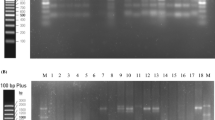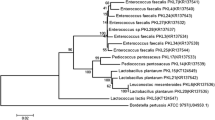Abstract
Ethnic tribals of Northeast India are known to prepare local beverages using indigenous technology. Exopolysaccharide (EPS) producing lactic acid bacteria are responsible for the alteration of wine and other fermented beverages. Isolated from ethnically fermented beverage (Kyiad pyrsi), Leuconostoc lactis in the present study, was investigated for EPS production. EPS productions were evaluated on MRS sucrose media and Ruthenium red milk agar plate. It was found that L. lactis had the yield of EPS (340.82 mg/l) which was found to be lower than Leuconostoc mesenteroides reported from wine which produced 904 mg/l. Microtiter plate assay on biofilm of the isolates was used for optimization of EPS production. Fructose, glucose, galactose, mannose, lactose, sucrose and ribose were used as carbohydrate sources, while pH of 5.0, 5.5, 6.0, 6.5 7.0, 8.0 and temperatures of 28, 37 and 45 °C were considered for production optimization. Sucrose, pH 6.5 and incubation temperature of 28 °C were found to be optimal conditions for EPS production by the isolate.





Similar content being viewed by others
References
Tamang JP, Fleet GH (2009) Yeasts diversity in fermented foods and beverages. In: Satyanarayana T, Kunze G (eds) Yeast biotechnology: diversity and applications. Springer, New York, pp 169–198
Rapsang GF, Joshi SR (2012) Bacterial diversity associated with tungtap, an ethnic traditionally fermented fish product of Meghalaya. Ind J Trad Knowl 11:134–138
Rapsang GF, Kumar R, Joshi SR (2011) Identification of Lactobacillus pobuzihii from tungtap: a traditionally fermented fish food, and analysis of its bacteriocinogenic potential. Afr J Biotechnol 10:12237–12243. doi:10.5897/AJB10.2618
Sohliya I, Joshi SR, Bhagobaty RK, Kumar R (2009) Tungrymbai- Traditional fermented soybean food of the ethnic tribes of Meghalaya. Ind J Trad Knowl 8:559–561
Tamang JP, Holzapfel WH (1999) Biochemical identificaton techniques-modern techniques: Microfloras of fermented foods. In: Robinson RK, Batt CA, Patel PD (eds) Encyclopaedia of food microbiology. Academic Press, London
Thokchom S, Joshi SR (2012) Microbial and chemical changes during preparation in the traditionally fermented soybean product tungrymbai of ethnic tribes of Meghalaya. Ind J Trad Knowl 11:139–142
Bousbouras GE, Kunkee RE (1971) Effect of pH in malolactic fermentation in wine. Am J Enol Vitic 22:6–121
Kelly WJ, Asmundson RV, Hopcraft DH (1989) Growth of Leuconostoc olnos under anaerobic conditions. Am J Enol Vitic 40:277–282
Girard M, Schaffer-Lequart C (2007) Gelation and resistance to shearing of fermented milk: role of exopolysaccharides. Int Dairy J 17:666–673. doi:10.1016/j.idairyj.2006.08.007
Oda M, Hasegawa H, Komatsu S, Kambe M, Tsuchiya F (1983) Antitumor polysaccharide from Lactobacillus sp. Agric Biol Chem 47:1623–1625
Nagaoka M, Hashimito S, Watanabe T, Yokokura T, Mori T (1994) Antiulcer effects of lactic acid bacteria and their cell wall polysaccharides. Biol Pharm Bull 17:1012–1017
Chabot S, Yu HL, De Leseleuc L, Cloutier D, Van Calsteran MR, Lessard M (2001) Exopolysaccharides from Lactobacillus rhamnosus RW-9595 M stimulate TNF, IL-6 and IL-12 in human and mouse cultured immunocompetant cells, and IFN-γ in mouse splenocytes. Le Lait 81:683–697
Kitazawa H, Harata T, Uemura J, Saito T, Kaneko T, Itoh T (1998) Phosphate group requirement for mitogenic activation of lymphocytes by an extracellular phosphopolysaccharide from Lactobacillus delbrueckii ssp. bulgaricus. Int J Food Microbiol 40:169–175. doi:10.1016/S0168-1605(98)00030-0
Llauberes RM, Richard B, Lonvaud A, Dubourdieu D, Fournet B (1990) Structure of an exocellular b-d-glucan from Pediococcus sp., a wine lactic bacteria. Carbohydr Res 203:103–107
Manca de Nadra MC, Strasser de Saad AM (1995) Polysaccharide production by Pediococcus pentosaceus from wine. Int J Food Microbiol 27:101–106. doi:10.1016/0168-1605(94)00118-P
Whiting GC (1975) Some biochemical and flavour aspects of lactic acid bacteria in ciders and alcoholic beverages. In: Carr G, Cutting CV, Whiting GC (eds) Lactic acid bacteria in beverages and food. Academic Press, London, pp 69–86
Williamson DH (1959) Studies on lactobacilli causing ropiness in beer. J Appl Bacteriol 22:392–402
Gamar L, Blondeau K, Simonet JM (1997) Physiological approach to extracellular polysaccharide production by Lactobacillus rhamnosus strain C83. J Appl Microbiol 83:281–287
Smitinont T, Tansakul C, Tanasupawat S, Keeratipibul S, Navarini L, Bosco M, Cescutti P (1999) Exopolysaccharide-producing lactic acid bacteria strains from traditional Thai fermented foods: isolation, identification and exopolysaccharide characterization. Int J Food Microbiol 51:105–111
Xu R, Ma S, Wang Y, Liu L, Li P (2010) Screening, identification and statistic optimization of a novel exopolysaccharide producing Lactobacillus paracasei HCT. Afr J Microbiol Res 4:783–795
De Vuyst L, Vanderverken F, Van de Van S, Degeest B (1998) Production by and isolation of exopolysaccharides from Streptococcus thermophilus grown in a milk medium and evidence for their growth associated biosynthesis. J Appl Microbiol 84:1059–1068. doi:10.1046/j.1365-2672.1998.00445.x
Martensson O, Duenas-Chascob M, Irastorzab A, Oste R (2003) Comparison of growth characteristics and exopolysaccharide formation of two lactic acid bacteria strains, Pediococcus damnosus 2.6 and Lactobacillus brevis G-77, in an oat-based, nondairy medium. Lebensm-Wiss Technol 36:353–357. doi:10.1016/S0023-6438(03)00020-3
Macedo MG, Lacroix C, Gardner NJ, Champagne CP (2002) Effect of medium supplementation on exopolysaccharide production by Lactobacillus rhamnosus RW-9595M in whey permeate. Int Dairy J 12:419–426
Yeniel N, Beyatli Y, Aslim B, Yuksekdag ZN (2006) Designated production of exopolysaccharide (EPS) and lactic acid with sugarbeet molasses by some lactic acid bacteria. Zuckerindustrie 131:841–845
Yeesang C, Chanthachum S, Cheirslip B (2008) Sago starch as a low cost carbon source for exopolysaccharide production by Lactobacillus kefiranofaciens. World J Microbiol Biotechnol 24:1195–1201. doi:10.1007/s11274-007-9592-3
Årsköld E, Svensson M, Grage H, Roos S, Rådström P, van Niel EdWJ (2007) Environmental influences on exopolysaccharide formation in Lactobacillus reuteri ATCC 55730. Int J Food Microbiol 116:159–167
Ibarburu I, Aznar R, Elizaquível P, García-Quintáns N, López P, Munduate A, Irastorza A, Dueñas MT (2010) A real-time PCR assay for detection and quantification of 2-branched (1,3)-β-d-glucan producing lactic acid bacteria in cider. Int J Food Microbiol 143:26–31. doi:10.1016/j.ijfoodmicro.2010.07.023
Harrigan WF (1998) Laboratory methods in food microbiology. Academic Press, London
Holt JG, Krieg NR, Sneath PHA, Staley JT, Williams ST (2000) Bergey’s manual of determinative bacteriology. Lippincott Williams & Wilkins, Philadelphia
Tamura K, Dudley J, Nei M, Kumar S (2007) MEGA4: molecular evolutionary genetics analysis (MEGA) software version 4.0. Mol Bio Evol 24:1596–1599. doi:10.1093/molbev/msm092
Bounaix MS, Gabriel V, Morel S, Robert H, Rabier P, Simeon MR, Gabriel B, Faucher CF (2009) Biodiversity of exopolysaccharides produced from sucrose by sourdough lactic acid bacteria. J Agric Food Chem 57:10889–10897. doi:10.1021/jf902068t
Madiedo PR, deLos Reyes-Gavilan CG (2005) Invited review: methods for the screening, isolation and characterization of exopolysaccharide produced by lactic acid bacteria. J Dairy Sci 88:843–856
Montersino S, Prieto A, Munoz R, de las Rivas B (2008) Evaluation of exopolysaccharide production by Leuconostoc mesenteroides strains isolated from wine. J Food Sci 4:196–199. doi:10.1111/j.1750-3841.2008.00726.x
Dubois M, Gilles KA, Hamilton JK, Rebers PA, Smith F (1956) Colorimetric method for determination of sugars and related Substances. Anal Chem 28:350–356
Habibi N, Soleimanian-Zad S, Zeinoddin MS (2011) Exopolysaccharides produced by pure culture of Lactobacillus, Lactococcus and Yeast isolated from Kefir Grain by microtiter plate assay: optimization and comparison. World Appl Sci J 12:742–750
Stepanovic S, Vukovic D, Dakic I, Savic B, Svabic-Vlahovic M (2000) A modified microtiter-plate test for quantification of staphylococcal biofilm formation. J Microbiol Methods 40:175–179
Van Geel-Schutten GH, Flesh F, ten Brink B, Smith MR, Dijkhuizen L (1998) Screening and characterization of Lactobacillus strains producing large amounts of exopolysaccharides. Appl Microbiol Biotechnol 50:697–703
Gancel F, Novel G, Carcano D, Loones A, Ramos P (1989) Selection process for bacterial clones producing exopolysaccharide(s) or muc (plus), by adding cationic colourant to culture medium of bacterial strain. Sodima Union Corp., assignee. French patent FR2632968-A
Stingele F, Neeser JR, Mollet B (1996) Identification and characterization of the EPS (Exopolysaccharide) gene cluster from Streptococcus thermophilus Sfi6. J Bacteriol 178:1680–1690
Morin A (1998) Screening of polysaccharide-producing microorganisms, factors influencing the production and recovery of microbial polysaccharides. In: Dumitriu S (ed) Polysaccharides–structural diversity and functional versatility. Marcel Dekker Inc Publication, New York, pp 275–296
Nicolaus B, Schiano MV, Lama L, Poli A, Gambacorta A (2004) Polysaccharides from extremophilic microorganisms. Origins Life Evol Biospheres 34:159–169
Gorret N, Maubois JL, Engasser JM, Ghoul M (2001) Study of the effects of temperature, pH and yeast extract on growth and exopolysaccharides production by Propionibacterium acidi-propoinici on milk microfiltrate using a response surface methodology. J Appl Microbiol 90:788–796
Acknowledgments
Authors acknowledge the financial support received from Department of Electronics & Information Technology (MC & IT) and partial support received from University Grants Commission, Govt. of India in the form of research grants.
Author information
Authors and Affiliations
Corresponding author
Rights and permissions
About this article
Cite this article
Joshi, S.R., Koijam, K. Exopolysaccharide Production by a Lactic Acid Bacteria, Leuconostoc lactis Isolated from Ethnically Fermented Beverage. Natl. Acad. Sci. Lett. 37, 59–64 (2014). https://doi.org/10.1007/s40009-013-0203-6
Received:
Revised:
Accepted:
Published:
Issue Date:
DOI: https://doi.org/10.1007/s40009-013-0203-6




